Innovation Toolkit – Tips, Tools and Templates for Managing Innovation
Having the right set of tools can help you get more out of your innovation activities by providing you with concrete ways for managing different parts of innovation. The right tools allow you to consider different aspects of innovation, look at innovation from new perspectives and save time.
It’s simply just more fun to use suitable tools that support different stages of innovation!
Table of contents
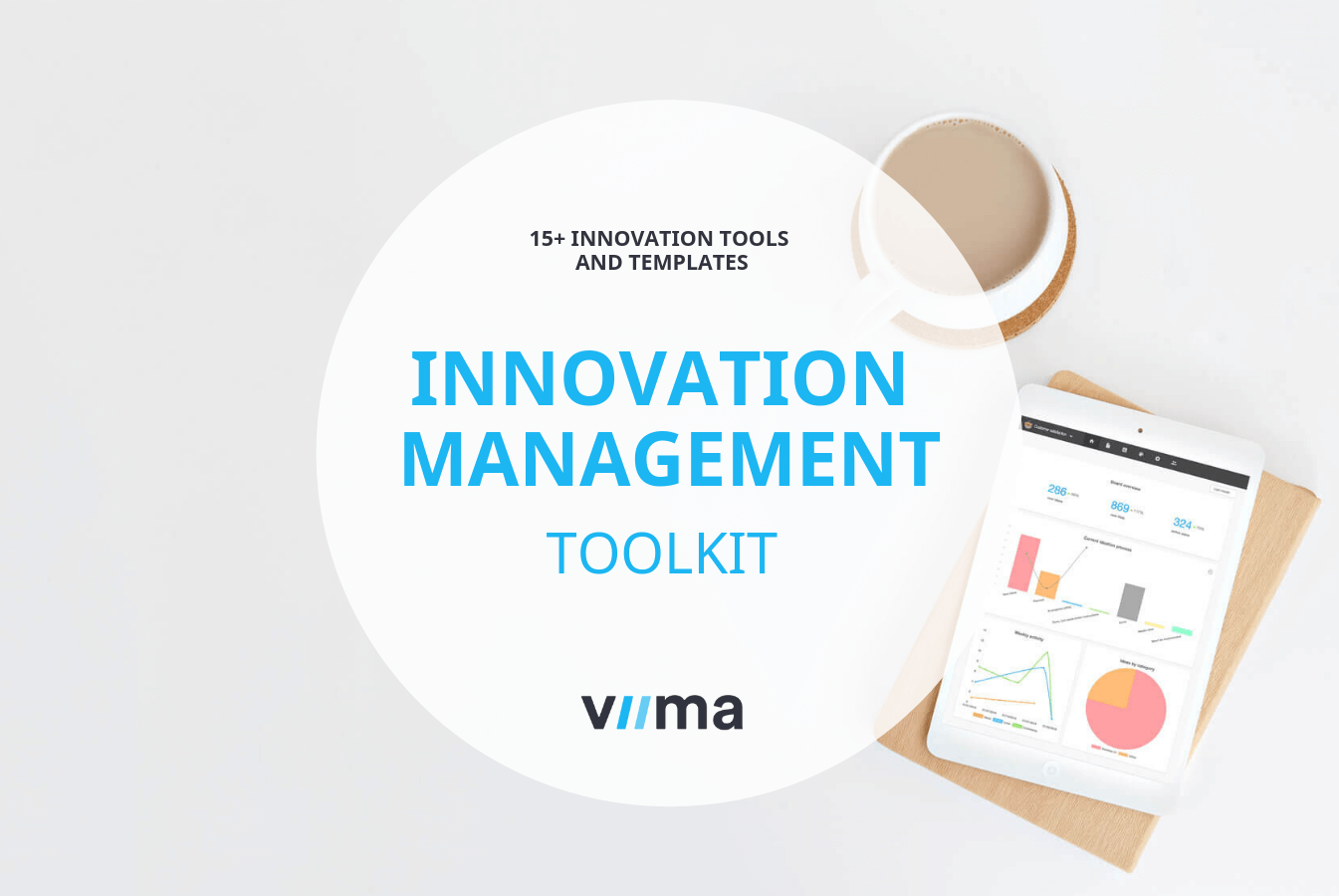
There are, however, so many tools for different innovation purposes that it can be difficult to know which ones are worth giving a go before testing them in practice. Thus, we’ve decided to collect some of our favorite innovation tools, tips, and templates in one place. In this post, we'll introduce how to use each of them as well as where they fit in the big picture.
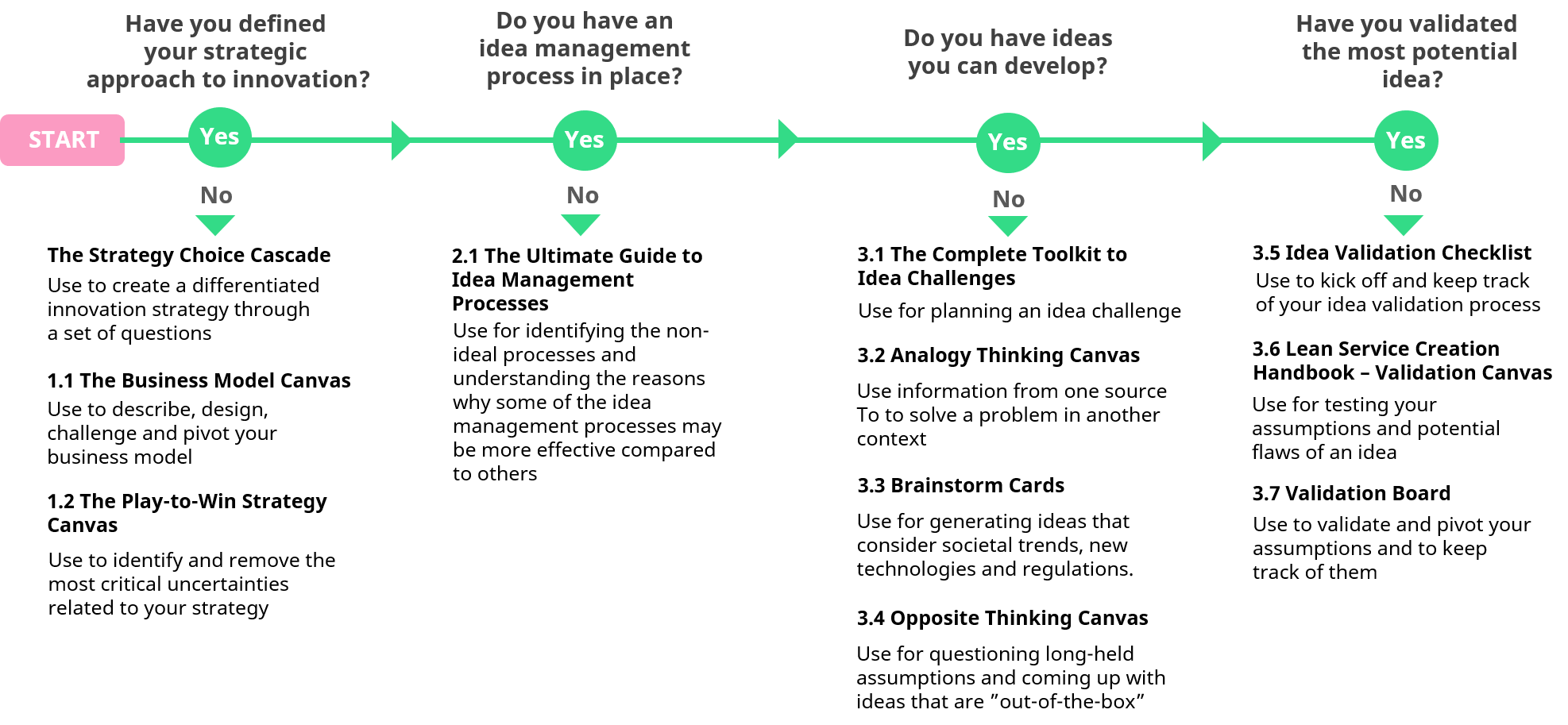
What is an innovation management toolkit and how to use it?
The purpose of the innovation management toolkit is to introduce a set of tools you can use to boost innovation in your organization. These tools can help you approach innovation more systematically, keep track of your progress and find new approaches to innovation.
We’ve tried to make the use of this toolkit as simple as possible by categorizing the tools based on the following themes:
- Innovation Strategy
- Innovation Process
- Idea Generation and Validation
- Idea Management Software
- Infographics
These five toolsets can be used independently, in workshops or as a part of a complete innovation process.
We’ve also included additional material to this toolkit, such as blog posts, that we believe are worth reading before getting started with each topic.
If, however, you want to jump right to the introduction of the tools, click here.
Introduction to innovation
Key aspects of innovation management
Innovation by definition is the introduction of something new. It can be a new idea, method or a physical invention that is launched to the public.
Because innovation management is such a broad and somewhat abstract topic, we’ve tried to make sense of it by dividing it into four key aspects. In practice, success in innovation requires that all four aspects are considered and that they work well together.
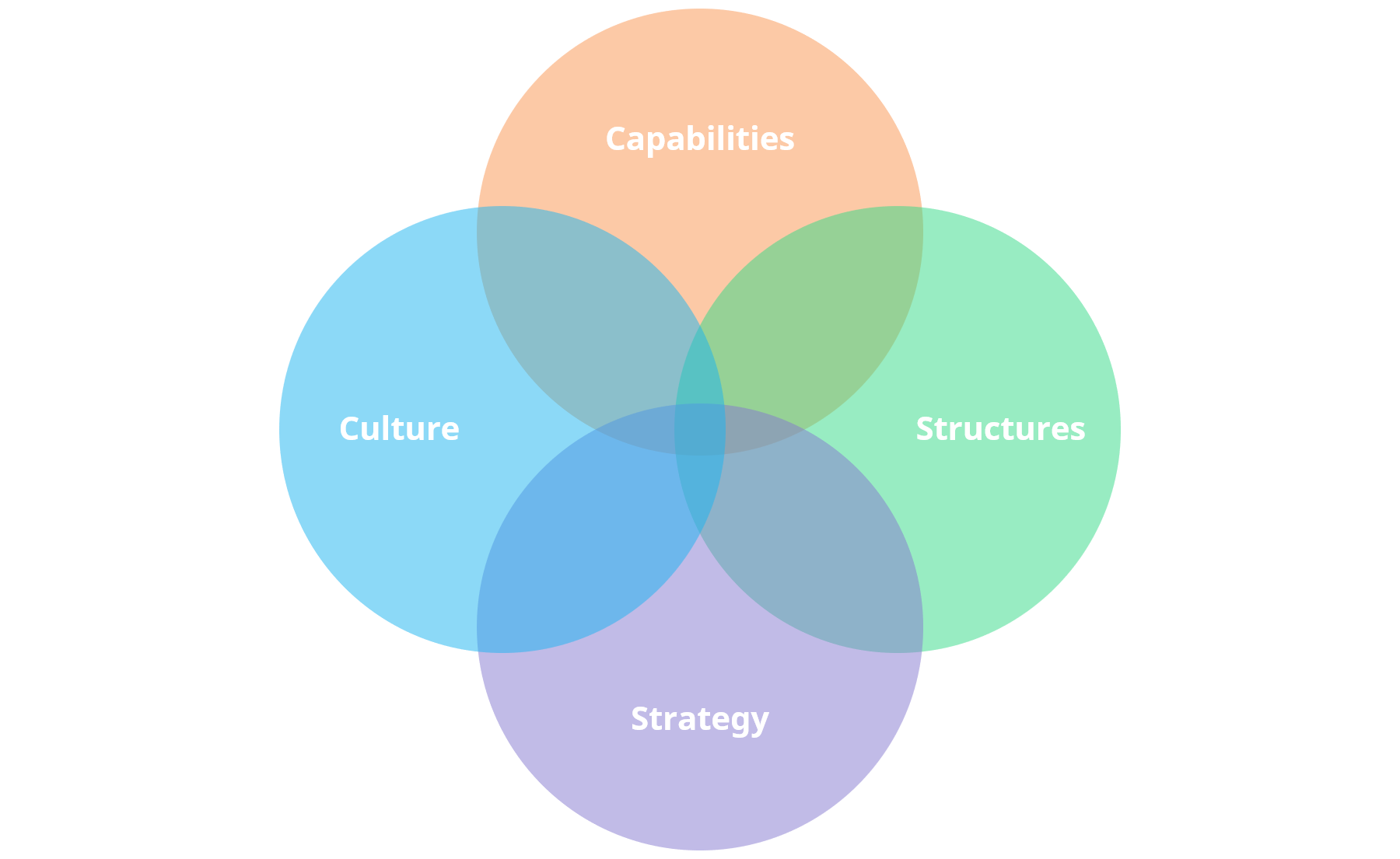
Culture
Culture refers to capabilities related to the people in the organization and is considered as one of the most important drivers of corporate innovation.
An innovative company culture emphasizes the need to always think of ways to get better. It values speed, continuous learning and experimentation and considers failure as just a normal part of the process for creating anything new.
Companies that foster an innovative culture acknowledge that innovation can come from anyone in the organization – not just from the top. These organizations provide enough freedom and responsibility for the people working for the company and is led primarily with vision instead of a chain-of-command approach.
Recommended reading: Transforming Corporate Culture with Innovation Practices
Capabilities
Capabilities refer to the resources an organization has for creating and managing innovation. These capabilities are also primarily revolving around people and include the abilities of both individuals and teams collectively.
Organizational capabilities include:
- Information capital
- Practical skills of the people
- Tacit knowledge
- Unique insights
Other resources, such as financial capital might also be needed to be able to create innovation as you often need to invest some money to be able to test and launch new ideas.
This, however, doesn’t mean that you have to invest billions to succeed. In fact, according to both the 2017 PwC Innovation Benchmark and the 2011 Global Innovation 1000 reports, the best innovators aren’t usually the ones with the biggest R&D budgets but the ones that are able to create the most value for their customers.
Structures
Organizational structure consists of different teams, processes, communication channels and infrastructure. It’s a system that outlines how certain activities are directed in order to achieve the goals of an organization. The right types of structures allow organizations to operate and innovate more effectively as they enable the effective use of the aforementioned capabilities.

The organizational structure also determines how information flows vertically and horizontally between different levels and teams of the company. The right communication channels make the feedback process smoother. When communication isn’t restricted and the information flows in all directions, it eventually has a positive effect on the internal operations of the company.
Strategy
The purpose of a strategy is to achieve competitive advantage by delivering a unique mix of value for your customers, and innovation is just one of the means to achieve your strategic goals. Strategy sets direction to your innovation performance and structures your innovation work.
What’s interesting is that 96% of executives have defined innovation as a strategic priority yet innovation/R&D strategy is the area where the board of director’s understanding is the weakest.
To be able to actually improve different areas of your business and achieve your goals, your innovation strategy should be aligned with your overall business strategy.
We’ll introduce a few tools for strategic alignment later in this post.
Recommended reading: Innovation Strategy – What is it and how to develop one?
Types of innovation
Each company has different strategies based on their unique strengths and capabilities, which means that there’s not just a single “right” way to innovate.
There are several different types of innovations for an organization to pursue and in this post, we’ve decided to introduce the the ones that are often used for classifying innovation and are easy to understand.
In general, organizations want to have different types of innovations in their innovation portfolio. This is of course to manage risk but also because different types of innovation are needed to achieve short-term and long-term goals.
To maximize your innovative potential, it might not be smart to put all your eggs in one basket but to allocate resources to all three horizons:
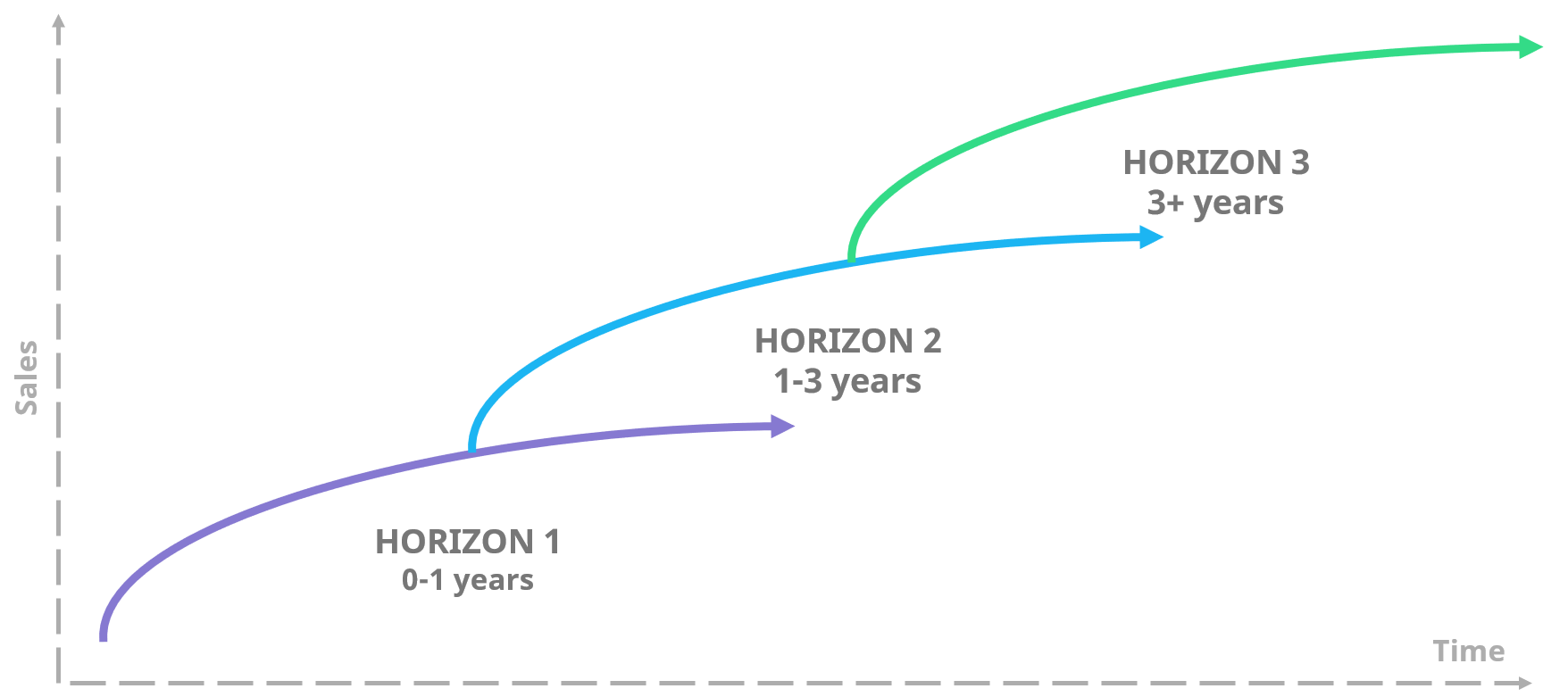
Recommended reading: Types of Innovation – The Ultimate Guide with Definitions and Examples
The Innovation Matrix
Disruptive and sustaining innovations describe the changes and impacts on the market, whereas radical and incremental innovations refer to technical improvements on products and processes, for example. Both disruptive and sustaining innovations can either be radical or incremental depending on how and where they’re happening.
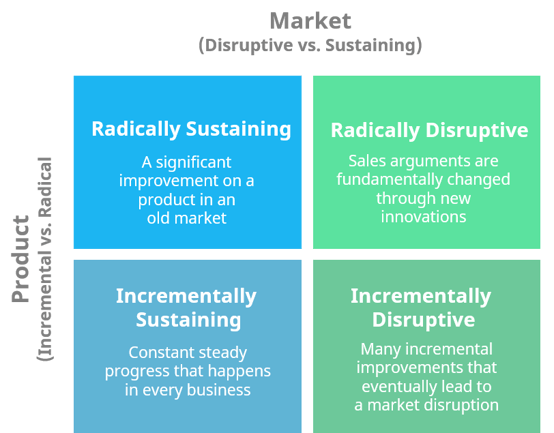
- Radically sustaining
An improvement on a product or a process in an old market that doesn’t change the sales argument of the product. Might require many tremendous technological innovations but doesn’t really affect whom consumers buy the product from or for what reasons, just provides them with more value.
- Radically disruptive
A form of innovation that creates or changes a market through a completely new sales argument. Has room to grow due to the public interest in the product and a lack of clear competitors.
- Incrementally sustaining
Sustaining innovation that builds incrementally is probably the most common form of innovation. It is the constant progress that's constantly happening in every business and is thus a vital factor for being able to compete. Incremental changes can be small, continuous improvements in any area of the business. - Incrementally disruptive
Incremental improvements that eventually lead to a dramatic disruption or even creates a new market. This is what's one day going to happen to the automotive industry with the electric car or healthcare industry with new technologies.
Recommended reading: How to Manage Disruptive Innovation – Introducing the Innovation Matrix
1. Innovation strategy tools
As already mentioned, strategy is about finding the best way to win between a number of feasible options. When it comes to innovation strategy, it guides you towards your long-term goals. In general, you should focus on doing things you have a realistic chance to win at.
“It’s only worth doing if you can win at it”.
For your innovation strategy to work, it needs to be aligned with your business strategy and seamlessly integrated to the ways of working. Clear communication as well as a few supporting metrics on all levels of an organization can help you get started with innovation and make it a continuous practice.
In this section, you'll find a few useful tools that can be used to define and align your business and innovation strategies, map your strategic decisions and remove the most critical uncertainties related to your idea, business or concept.
The Strategy Choice Cascade
The Strategy Choice Cascade is a model that builds on a known Playing-to-Win -theory, introduced by Robert L. Martin in a book bearing the same name. The Strategy Choice Cascade is often used to create a differentiated strategy through a set of questions.
We wanted to include the model here as these questions can help you align your innovation strategy with your overall business strategy.
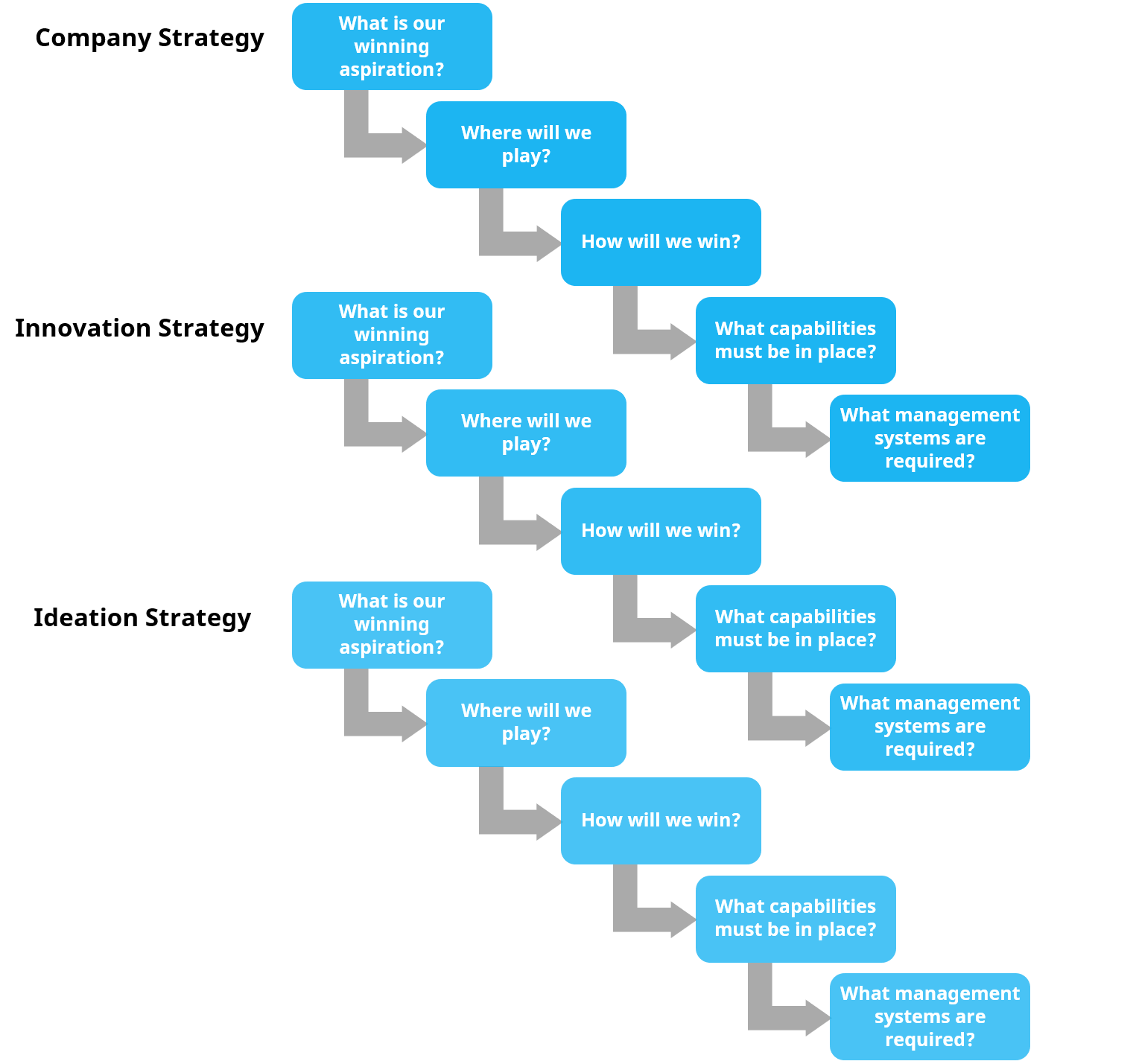
The Strategy Choice Cascade allows you to approach strategy in a systematic and structured manner and helps you:
- Determine your objectives to innovation
- Define your market and value proposition
- Assess and develop your core capabilities
- Establish your innovation techniques and systems
1.1 The Business Model Canvas
Once you have the answers to the aforementioned strategic questions, it’s time to map your strategic decisions and key assumptions related to your business idea or concept.
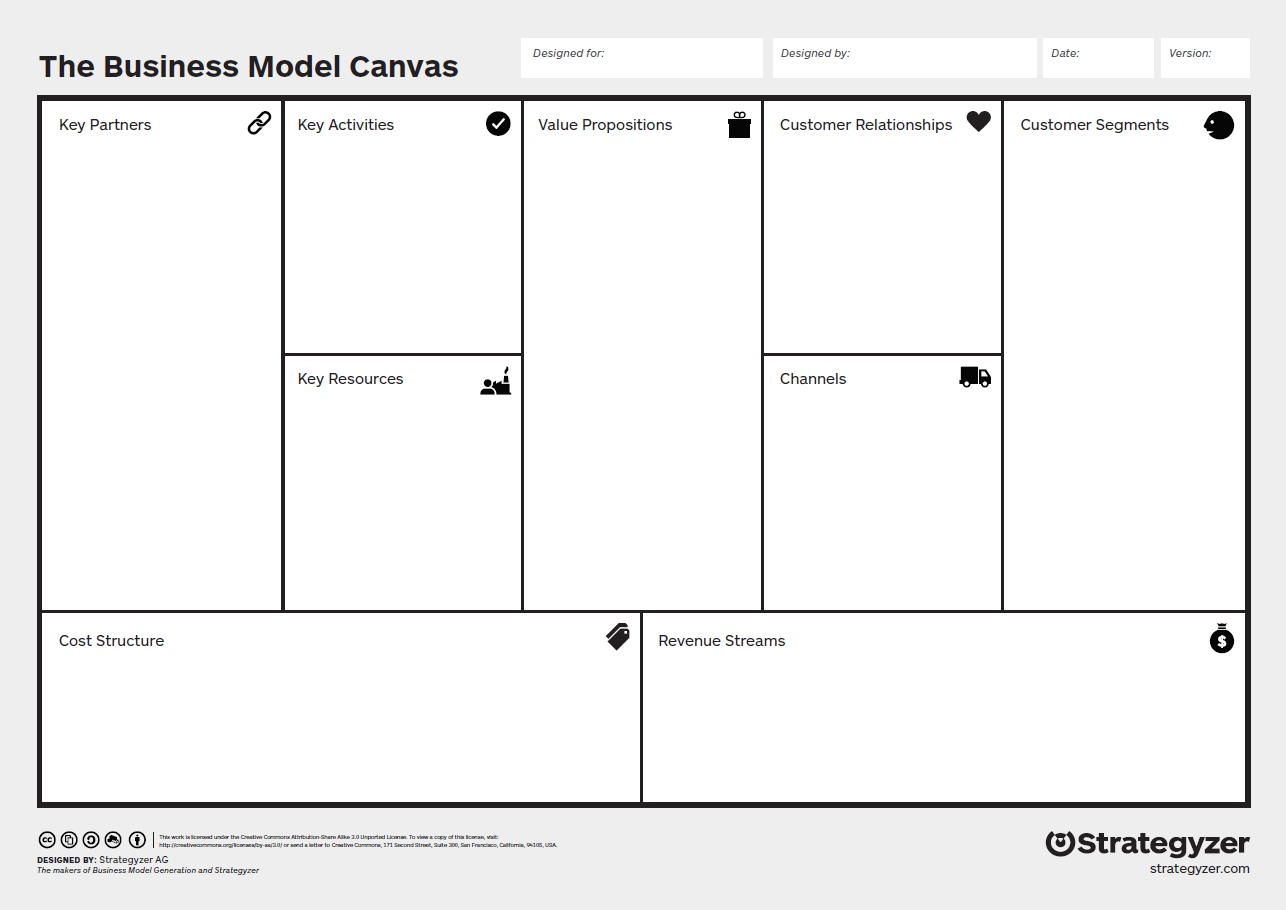
The Business Model Canvas is a template by Strategyzer and can be used to describe, design, challenge and pivot your business model. It works in conjunction with other strategic management and execution tools and processes and is best for designing and validating a scalable business model within the market.
With the help of the The Business Model Canvas, you can define, and map nine key strategic areas related to external and internal factors to understand what is required to make your idea a real business.
Recommended reading: How to: Business Model Canvas Explained
1.2 The Play-to-Win Strategy Canvas
The Play to-Win Strategy Canvas v 3.0 (Matthew E. May) is a tool that is also created based on The Playing-to Win theory. This canvas similar to the Business Model Canvas in a sense that it’s a visual tool for formulating and mapping your strategy.
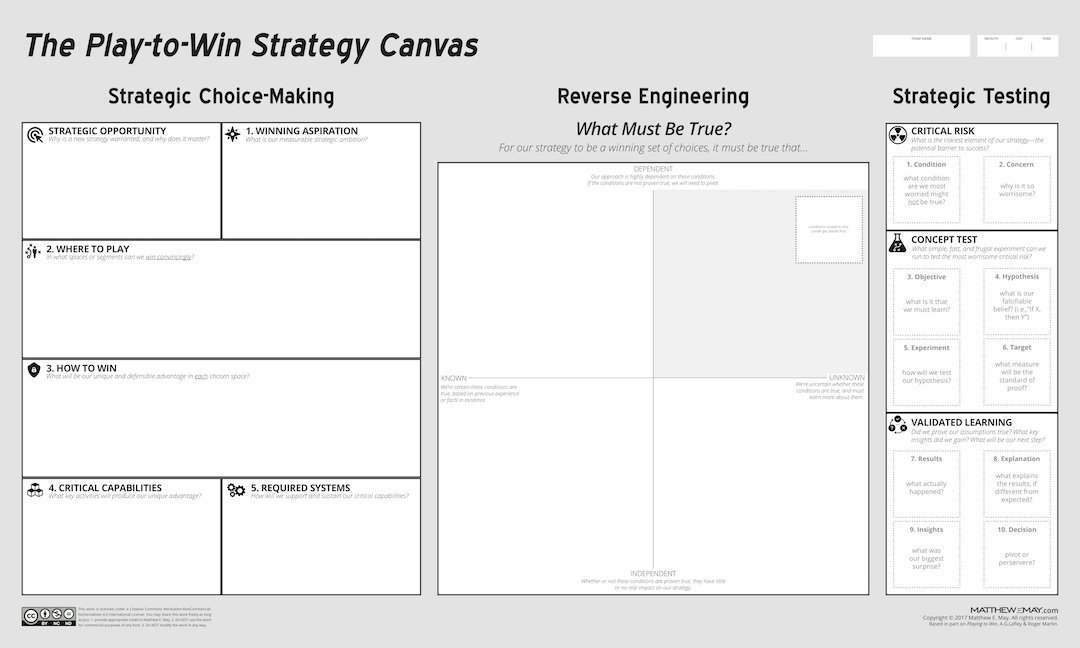
The difference between these two tools is that The Play-to-Win Strategy Canvas allows you to remove the most critical uncertainties regarding your idea before developing it further.
The purpose of this canvas is to help you identify what must be true for your strategy to be valid.
Recommended reading: What Strategy is and isn’t: Playing to Win
2. Innovation process tools
An innovation management process is a systematic approach for generating, prioritizing, evaluating and validating new ideas, as well as putting them into practice.
To be able to execute your strategy and to improve on new or existing ideas, it makes sense to build a structured process that works as a framework for development and implementation.
Often, you need a number a different processes to manage different types of innovations as it's impossible to manage incremental and radical innovations with a single process, for example.
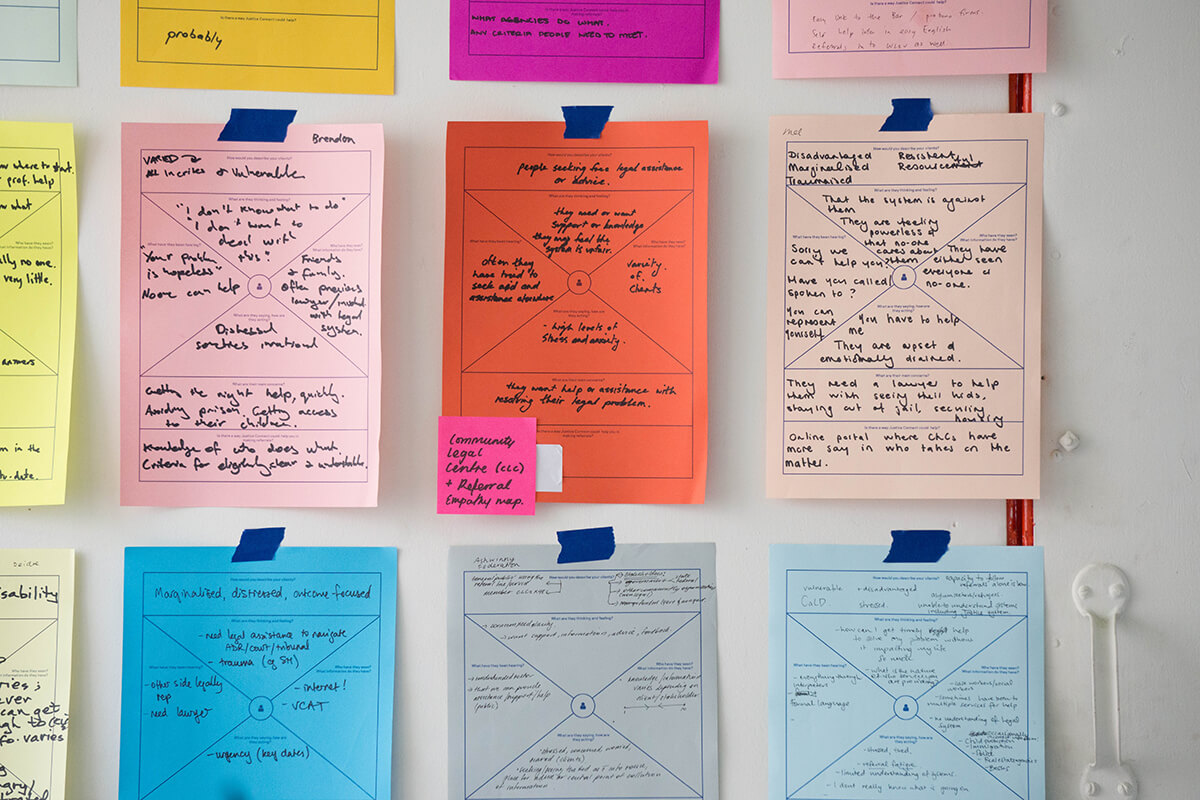
Why use a systematic process?
Although ideas are important, just having them is not enough as you still need to further develop and implement them to actually benefit from them.
Execution is the key for the success of an individual idea and the ability to implement several ideas effectively is only possible with the help of efficient mechanisms.
By defining a process for managing the ideas, you'll introduce clear responsibilities that will hold people accountable. A clear set of common rules make the process transparent and understandable for everyone and guides you through the innovation life cycle.
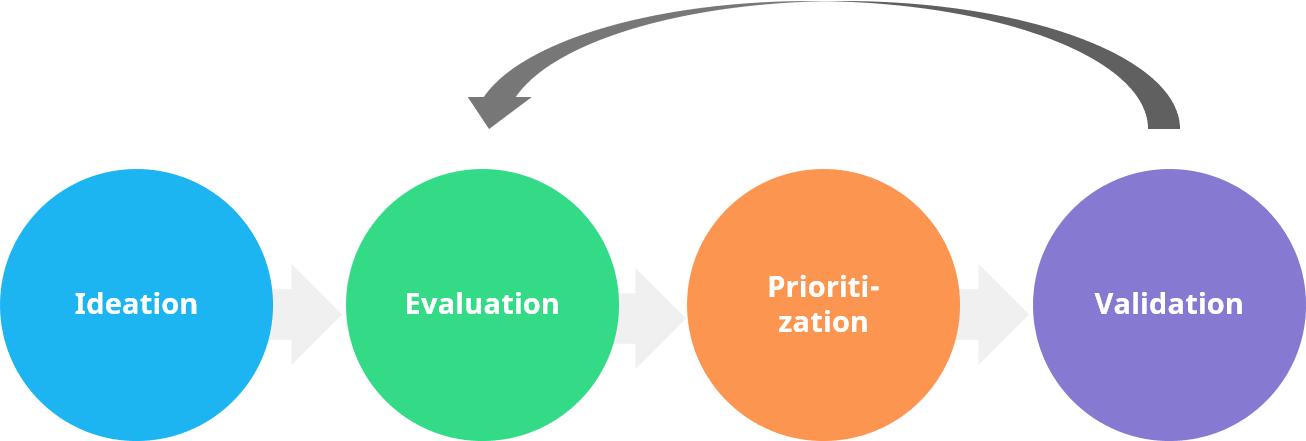
This, however, doesn't necessarily mean introducing heavy stage-gate processes. Although in some cases the stages can be very straightforward and standardized, there are cases that require a lot of freedom.
A systematic innovation process that is well suited for your purposes can help you to:
- make better decisions
- remove the bottlenecks
- enhance your efficiency
- reduce risks
- move faster by simplifying the otherwise complex process
Three processes for managing ideas
A general misconception is that all ideas can be managed through one innovation funnel. As already mentioned, there are different types of ideas that originate from different parts of the organization, which is why you often need multiple processes for managing new ideas.
We’ve listed three examples of idea management processes you can choose from. Although none of these are the one and only way to manage ideas, they can help you get started with creating your own process.
The Centralized Model
The centralized model can be defined as a hierarchy decision-making process where all decisions are handled strictly at the top level. It is often used by companies with less than 200 employees that have, to at least some extent, hierarchical organizations.
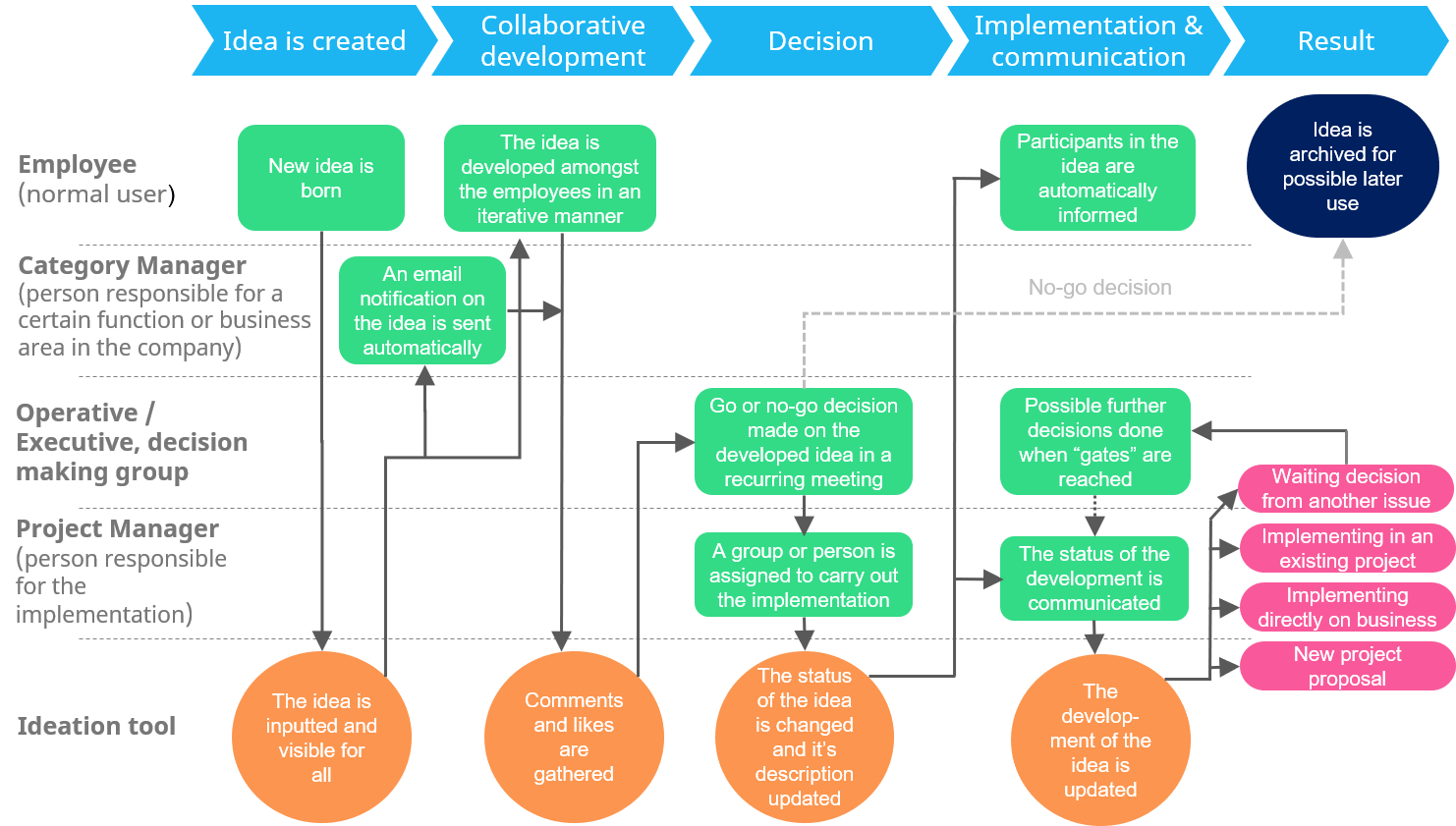
The Decentralized Model
On the opposite end of the spectrum is a decentralized model which relies on delegation of decision-making powers and flexibility. In this model, there's no central decision-makers deciding about the ideas but the responsibility is distributed.
The decentralized model is often used by companies with more than 200 but less than 500 employees with teams or business units that are used to making decisions independently.
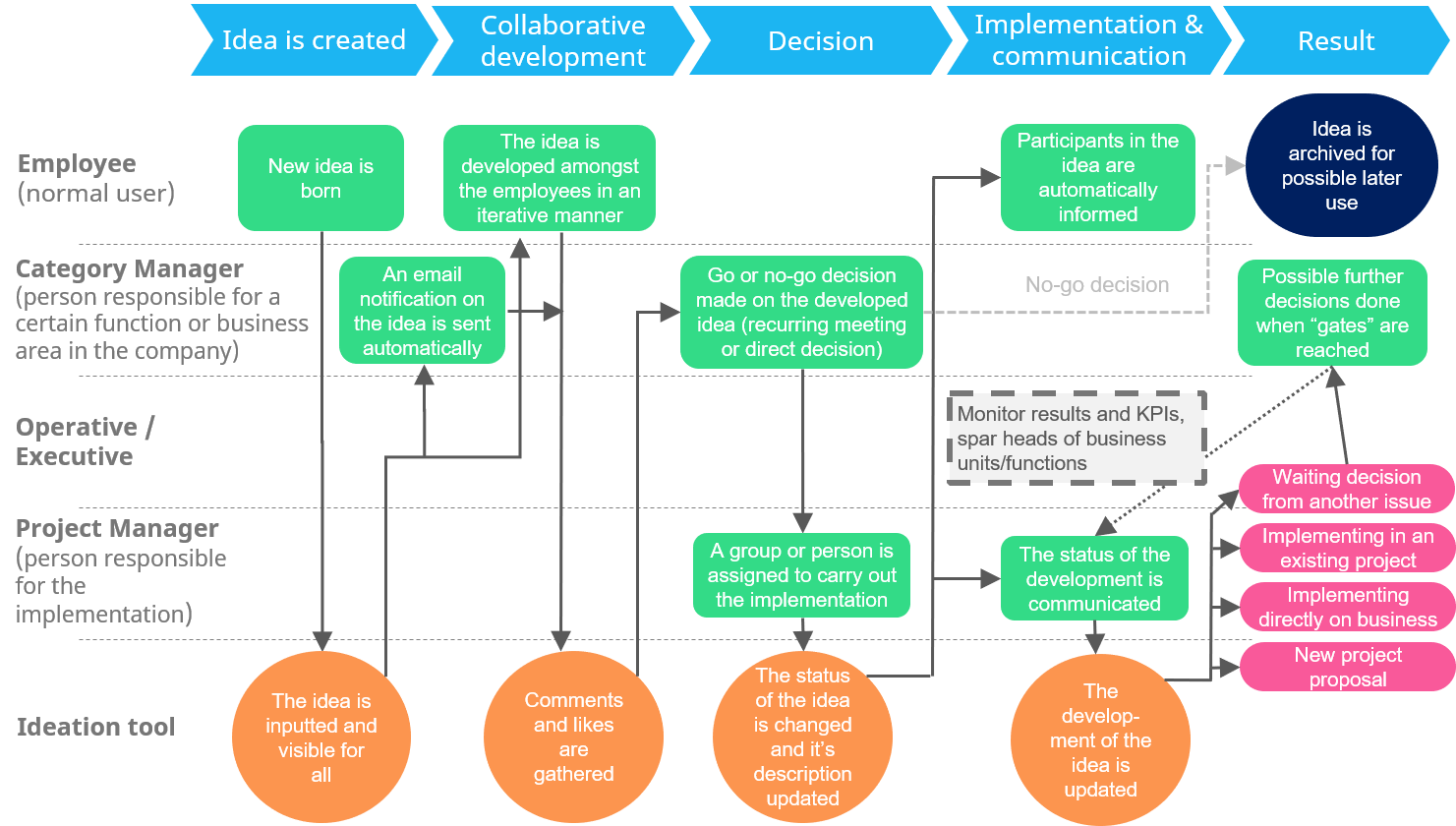
The Hybrid Model
The hybrid model is a combination of the centralized and the decentralized models. It uses different tracks for managing ideas which all have a dedicated decision maker or steering group to oversee them. These tracks can be either centralized or decentralized.
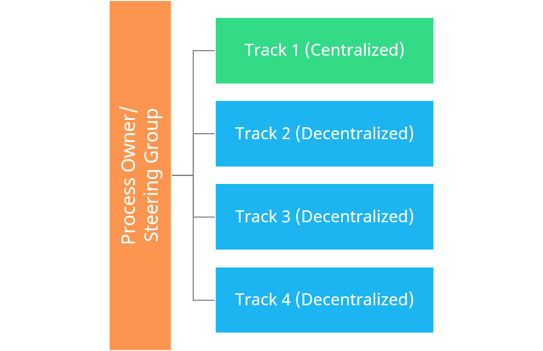
This model is often used by companies larger than 500 employees (but is not limited to them) and is especially used by companies that have different processes for ideas that are different by nature.
In order to be able to scale innovation in your organization, you need more than one person to make decisions on different levels of an organization. The dream is to have every employee understand the business as a whole and proactively develop every facet of the way they work.
Recommended reading: The Ultimate Guide to Idea Management Processes
2.1 The Ultimate Guide to Idea Management Processes
The Ultimate Guide to Idea Management Processes will look at the different idea management processes we've encountered with our prospects and customers. We'll introduce the models and talk a little bit about their characteristics and suitability for different kinds of companies.
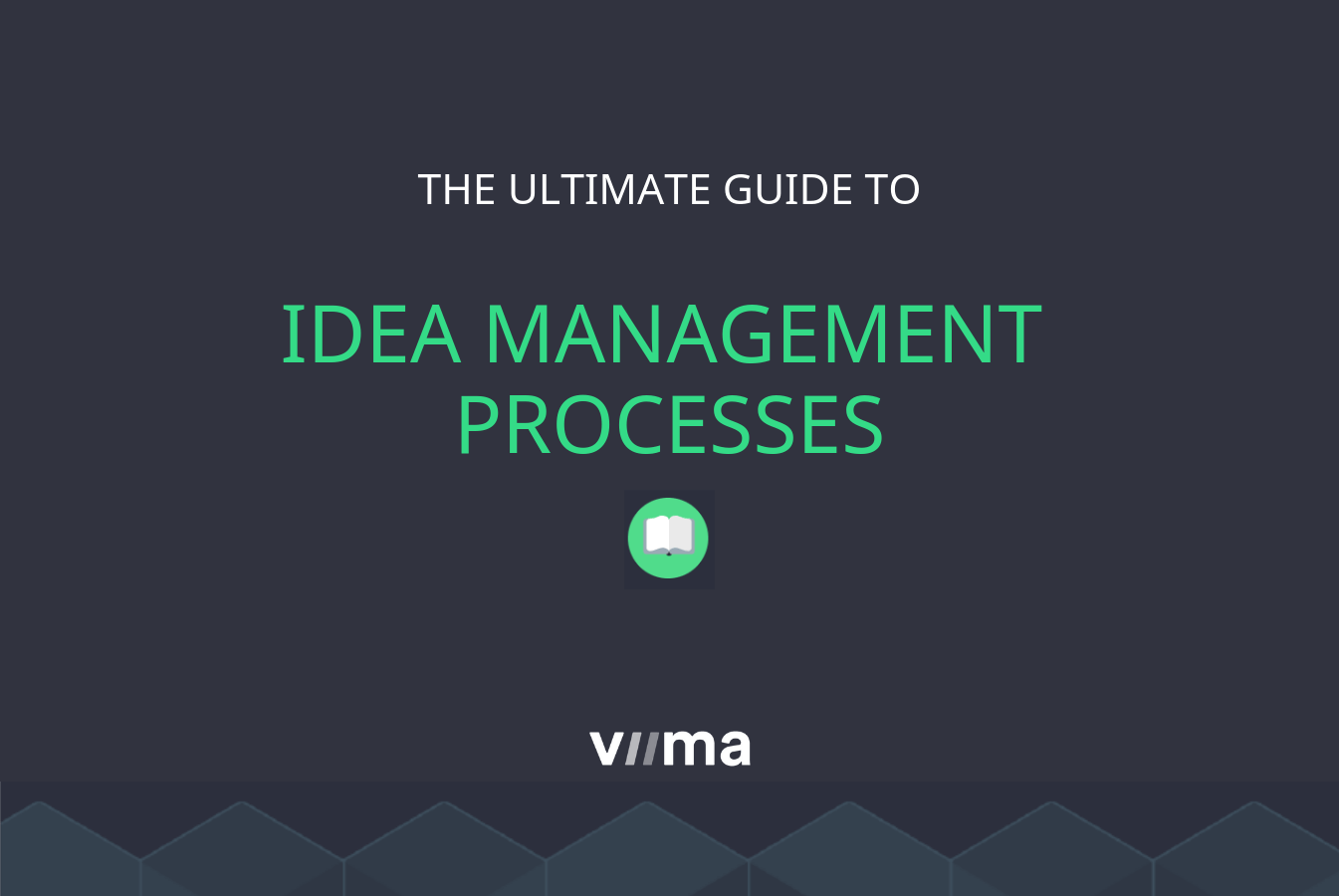
This guide can be used for identifying the non-ideal processes and understanding the reasons why some of the idea management processes may be more effective compared to others.
The guide contains:
- A 33 page eBook that introduces the most common idea management processes and discusses their suitability for different kinds of companies
- A PowerPoint template with editable slides of all the recommended processes
3. Innovation management tools
In this section, you’ll find some of our favorite tools for idea generation and idea validation. We’ll also explain how a transparent innovation management software can help make more innovation happen in your organization.
Idea Generation
Idea generation is described as the process of creating, developing and communicating ideas. It’s the front-end part of the idea management funnel and it focuses on coming up with possible solutions to perceived problems as well as identifying new interesting opportunities.
There are obviously different ways you can start generating new ideas and the most suitable method for you depends on what you want to achieve. New ideas can help you move forward if you feel stuck with a task or are unable to solve a certain problem and the right tools can help you come up with even better ideas.
Recommended reading: What is Idea Generation? – Definition, Techniques and Success Factors
3.1 The Complete Toolkit to Idea Challenges
If you’re looking to get more ideas from your employees, for example, we usually recommend starting with an idea challenge.

Idea challenge is a focused form of innovation where you raise a desire, concern, or area of improvement with the hopes of finding creative solutions. It typically starts off in the form of a question and is guided towards a specific audience.
Recommended reading: The Complete Guide to Idea Challenges
The Complete Toolkit to Idea Challenges helps you get started with your first idea challenge and guides you though the entire process from picking your theme and participants to planning and executing the challenge.
This PowerPoint Toolkit Contains:
- 15 slide templates for the idea challenge process
- 5 slides of email templates to help in communication throughout the challenge
- An editable copy of the Idea Challenge Canvas for designing and keeping track of your challenge
3.2 Analogy Thinking Canvas - Board of Innovation
If it’s not time for you to organize an idea challenge just yet, there are other ideation techniques you can use to come up with fresh ideas, such as The Analogy Thinking Canvas, a simple tool created by Board of Innovation that can be used for identifying and applying the best features from other solutions.
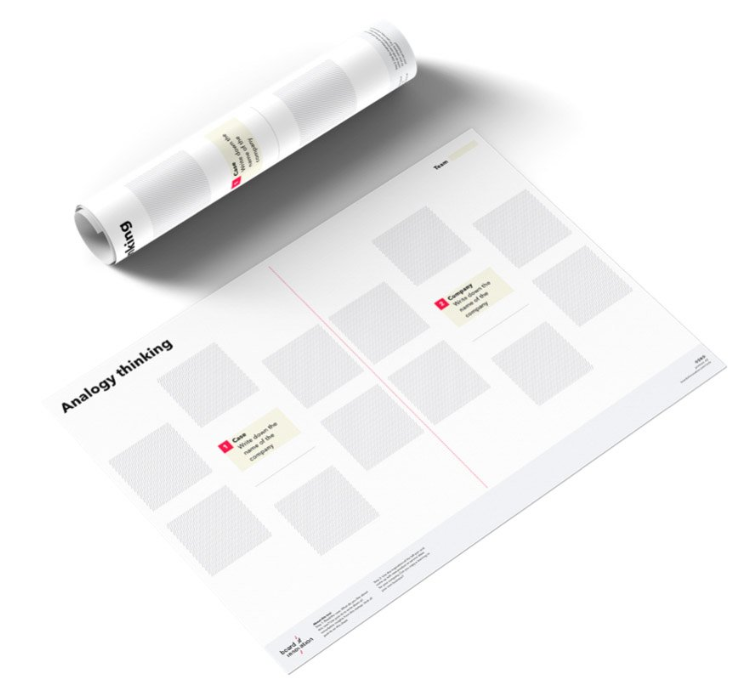
Analogy thinking is a technique for using information from one source to solve a problem in another context. Often, existing solution to a problem or opportunity can be used to solve another problem.
Analogy thinking can, for example, be used for analyzing a successful business, identifying what makes it great, and then applying those same principles for your business. This is an effortless method for coming up with new ideas that are, to some extent, pre-validated.
You should, however, be careful here as each business is unique and not everything works for everyone. Also,”Uber for dog walking [/insert industry here]” doesn't necessarily lead to very unique ideas.
3.3 Brainstorm Cards - Board of Innovation
Brainstorm cards are another useful tool for coming up with dozens of new ideas related to whatever challenge or problem you are currently working with.
Brainstorm cards can help you consider external factors such as: societal trends, new technologies, and regulations in the context of your business. It’s a fun tool that allows you to approach problems from multiple different perspectives that you might otherwise not have thought of.
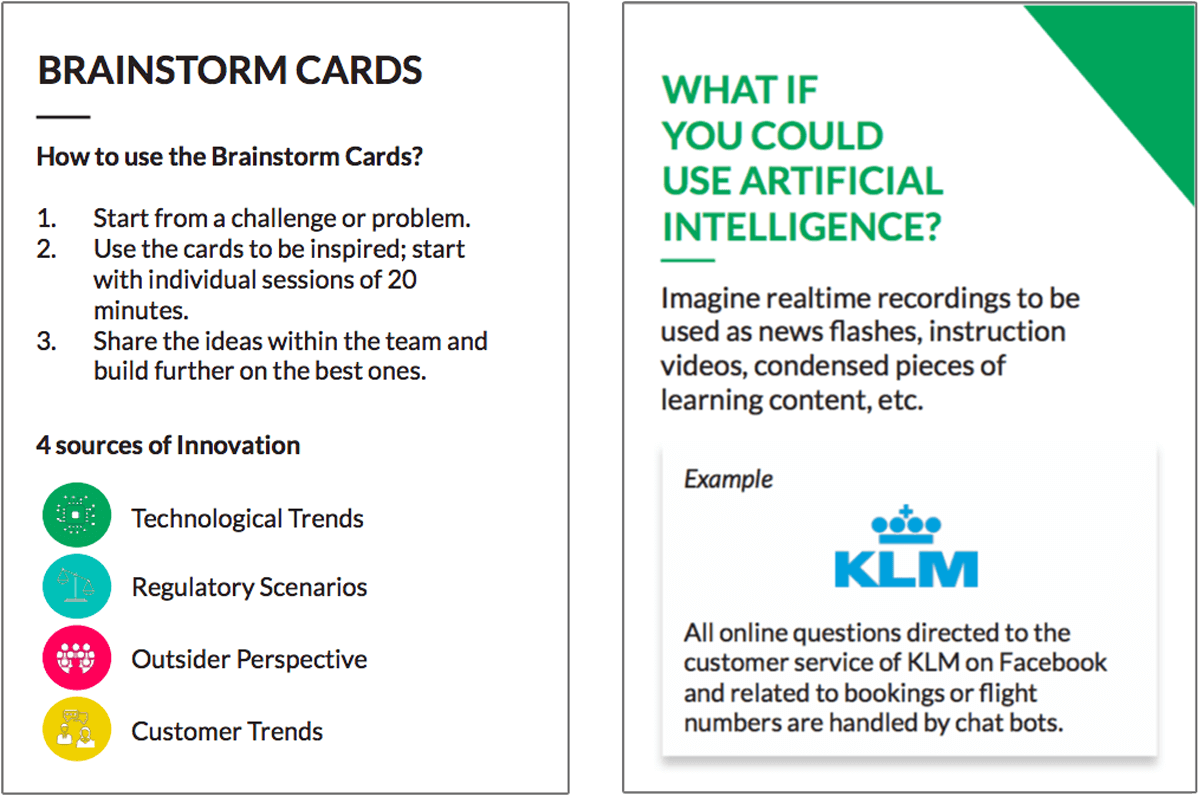
Although traditional brainstorming isn’t necessarily the most effective way to generate new ideas, these cards can be used to boost inspiration in a group or when ideating independently.
3.4 Opposite Thinking Canvas – Board of Innovation
Opposite/reverse thinking is a technique that can help you question long-held assumptions related to your business. It’s a useful tool to consider if you feel your team is stuck with the conventional mindset and coming up with those “out-of-the-box ideas” seems difficult.
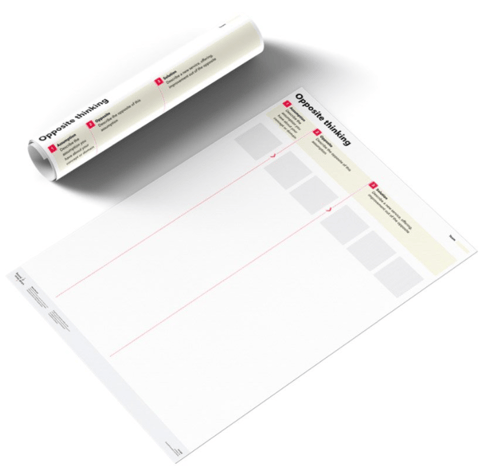
Often, the best solutions aren’t found through a linear thought process. Although our brains are wired that way, opposite thinking can help us question the norm. With this type of thinking, you consider the exact opposite of what first comes to mind.
The key to success with all of these idea generation tools is to define your problem or opportunity and to involve the right people in your ideation process. You can find more success factors for idea generation in the blog.
Recommended reading: Idea Generation: Definition, Techniques and Success Factors
Idea Validation
Idea validation is the process of gathering evidence around ideas through experimentation to make fast, informed and de-risked decisions.
New ideas have unpredictable elements and if some of them go wrong, it can destroy your plans at once. An idea should be validated before investing a significant amount of time and resources in developing it to avoid building and launching a product or concept no one wants or isn’t willing to pay for.
The purpose of idea validation is to expose the idea to the practicality of the real world before you build and release the final product or offering to the market to make sure your idea has real demand. Otherwise there’s a risk of it becoming “just another cool idea”.
Idea validation:
- reduces the risk of producing something that isn’t of value
- speeds up the delivery of a value-creating service in the market and minimizes the costs
The idea must either be able to solve a real problem, fulfill its intended purpose or appeal to other incentives.
There are multiple ways you can validate an idea but the main ideology behind the validation process is actually quite simple:
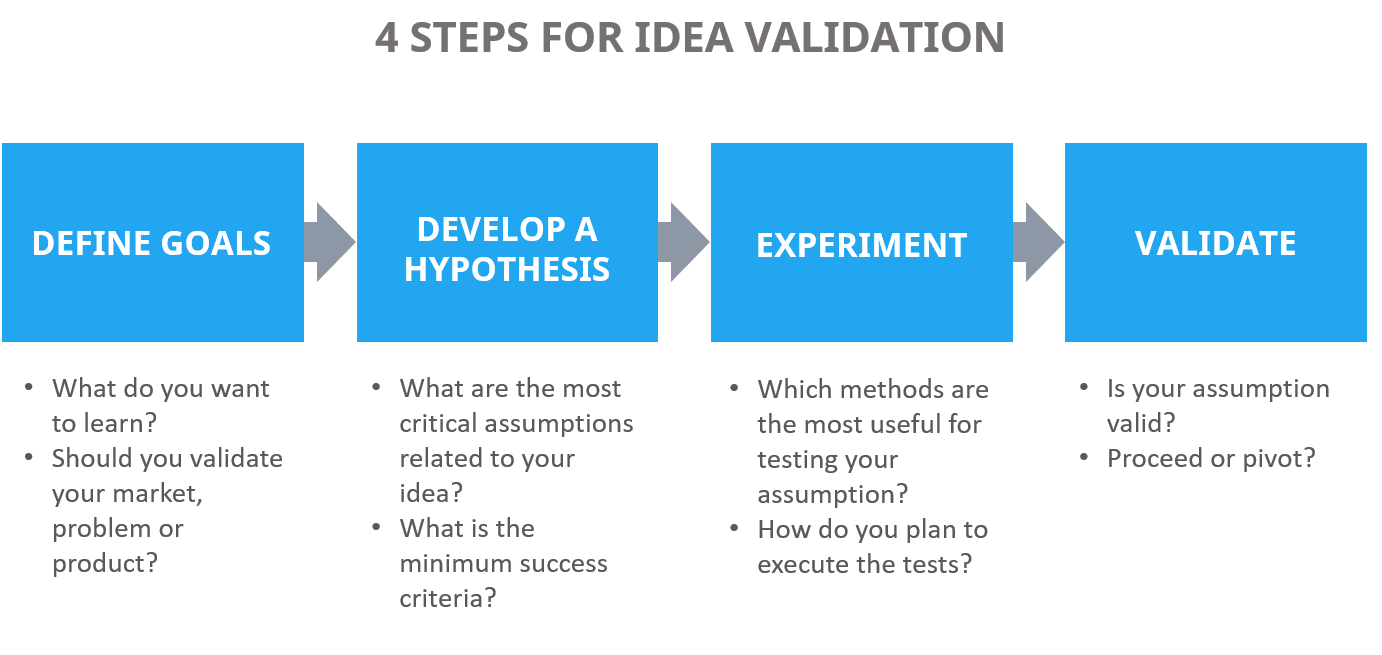
During this process, you want to focus on making sure that the most critical assumptions related to your idea are valid.
Recommended reading: Idea Validation: Steps and Tools for Testing Your Idea
3.5 Idea Validation Checklist
This simple, 4-step checklist can be used to kick off and keep track of your idea validation process. With the help of this idea validation checklist, you can:
- Monitor the progress of your validation process
- Set goals
- Develop a hypothesis
- Choose the best method for experimentation
3.6 Lean Service Creation Handbook – Validation Canvas
Validation Canvas is a tool by Lean Service Creation that can also be used to test your assumptions. Instead of looking for supportive arguments to prove that your idea is good, the point of Validation Canvas is to prove that it’s not.
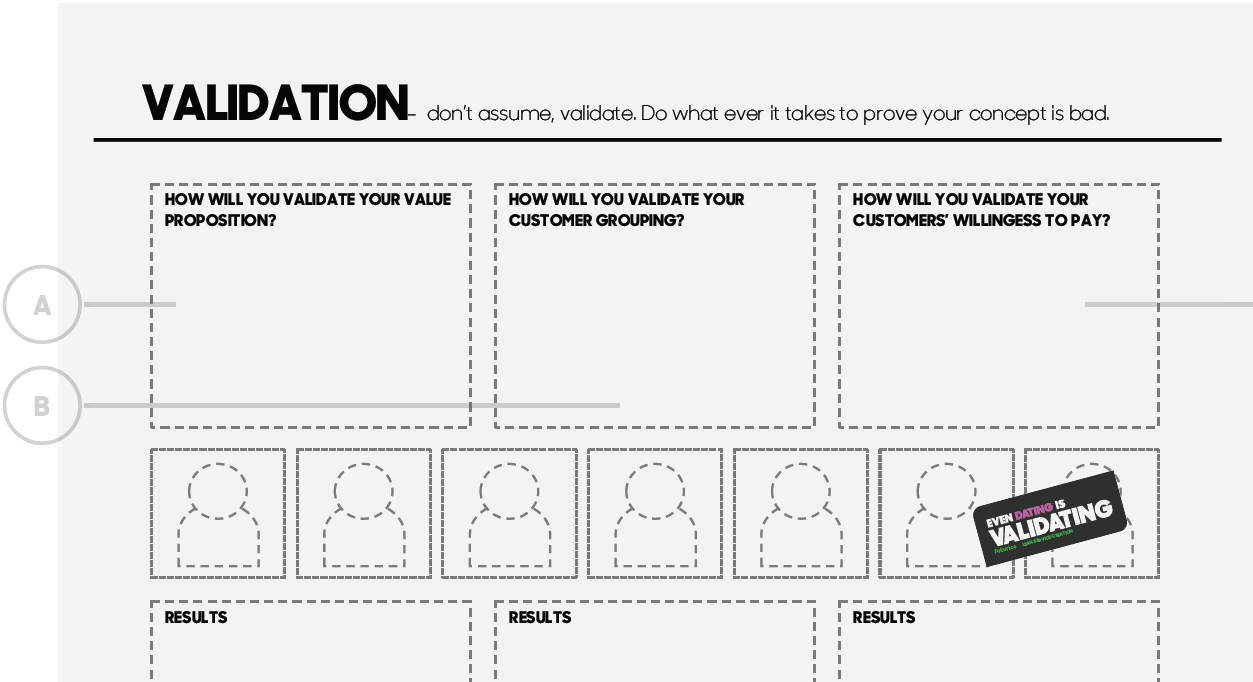
We’re naturally accustomed to searching for evidence that supports our point of view but aren’t often spending enough time on researching conflicting evidence. This tool allows you to really test whether your idea is good or bad and whether of not to proceed with it and is useful especially in the early phase of an idea.
In addition to the Validation Canvas, The Lean Service Creation Handbook includes tons of other useful canvases that you can use for making different kinds of experiments.
3.7 Validation Board - The Lean Startup Machine
The Validation Board is a tool that can be used to validate and pivot your assumptions and to track those pivots.
With the help of the Validation Board, you can define customer, problem and solution hypotheses, and identify the core assumptions related to these aspects.
If you’re looking for an actionable tool for setting goals and tracking multiple hypotheses at once, you’re likely to find this tool useful.
Innovation Management Software
A dedicated innovation management software can be tremendously helpful for managing activities, practices, processes and decisions that an organization uses to drive raw ideas all the way to concrete value generating innovations.
For many organizations, innovation can be a highly complex and multi-dimensional set of processes across multiple teams, business units, and divisions, which is why you should look for a software that is flexible, scalable and suitable for different use cases.
We’ve gathered a comprehensive list of different innovation management software here: 20 Best Innovation Management Tools – Choosing the Best One
If you’re looking for an innovation management software right now, you can get started with Viima, which is free for up to 50 users.
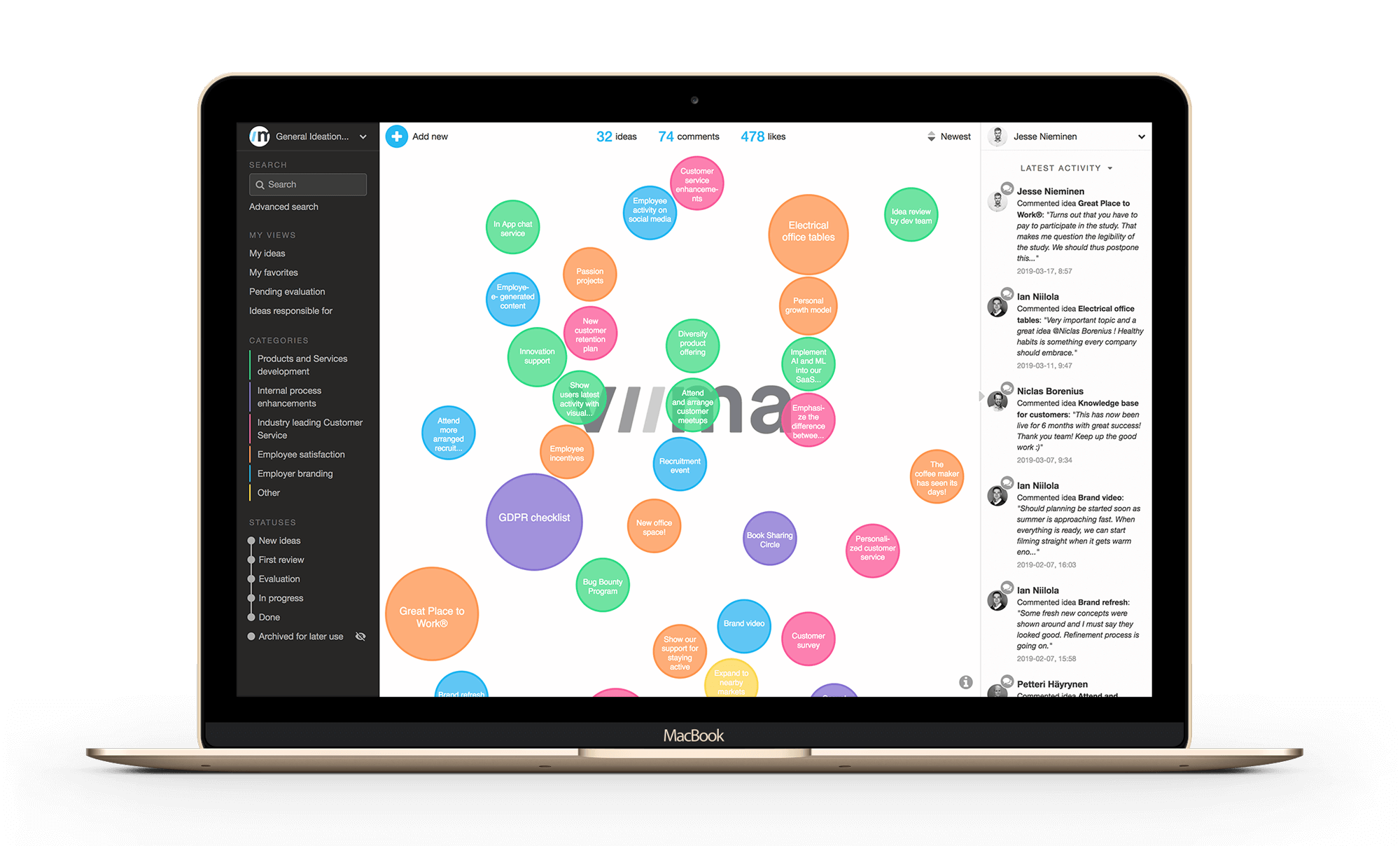
3.8 Guide to a Successful Ideation Software Pilot
We almost always recommend starting with a pilot when picking a tool for managing innovation. This Software Pilot Guide Contains:
- A 5-page eBook that helps you form your ideation process and pinpoint areas to improve upon based on the pilot
- A Simple Checklist to use as a reference when planning a successful ideation software pilot
- Viima Board Canvas to help you set goals, design your pilot, and to make sure you're on the right track
3.9 Viima Board Canvas
To succeed in ideation, it’s essential to approach your work holistically. Viima Board Canvas helps make sure none of the aspects of innovation is ignored and can be used for identifying elements and setting goals for different kinds of innovation and idea management processes/pilots.
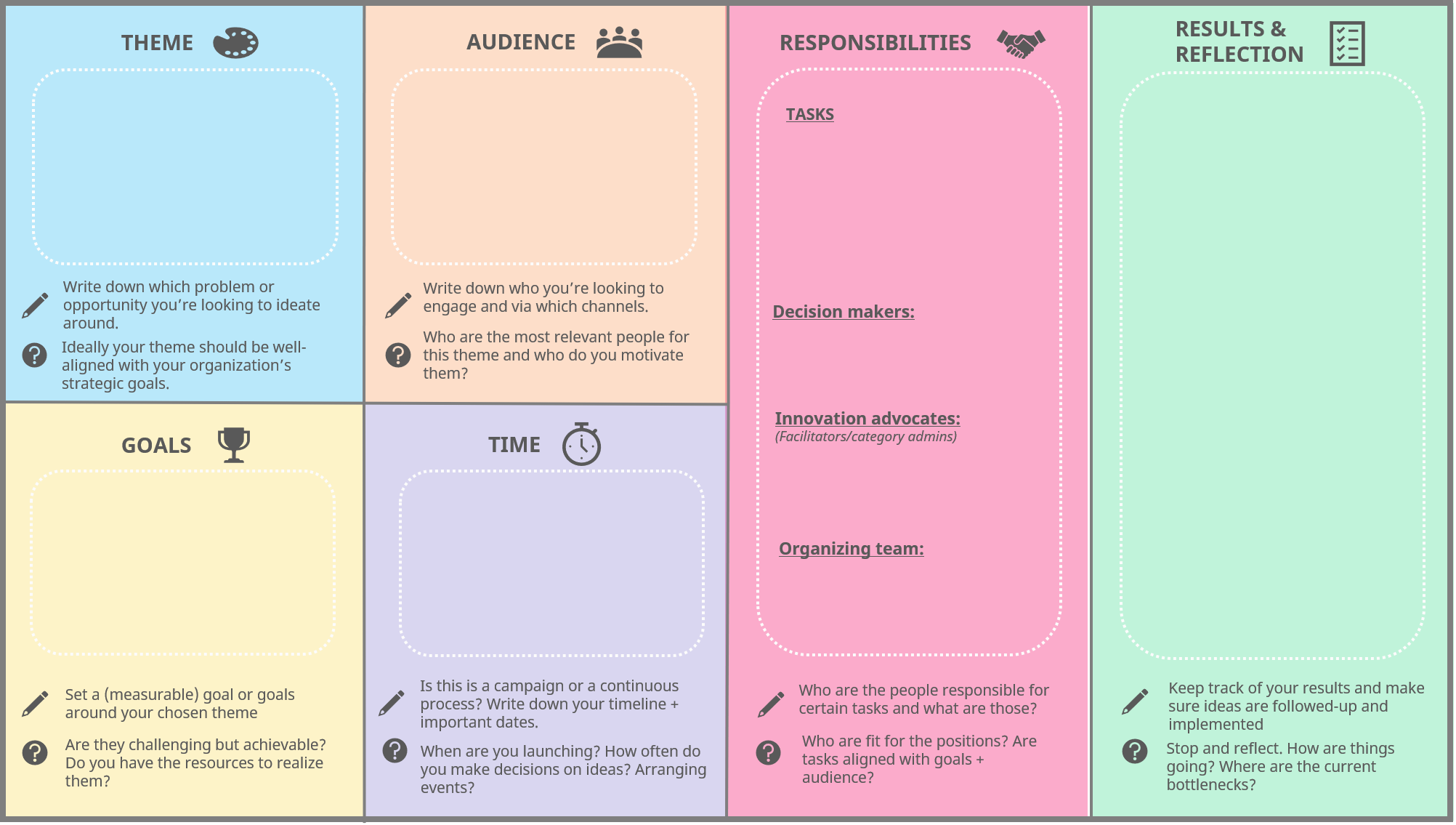
With the help of the Viima Board Canvas you can make decisions about the theme, audience, responsibilities, goals and time of your innovation activities.
4. Infographics
Infographics are a powerful way to summarize and communicate interesting facts. The final section of this toolkit introduces our most popular infographics that are created based on comprehensive blog posts about trending topics.
Communication can sometimes be a challenge and even though infographics aren’t as actionable compared to other tools, they can help make communication easier.
4.1 Infographic: How to Measure Innovation?
Finding the right metrics to measure innovation can be difficult. There are tons of different types of metrics you can measure but not all of those are relevant for everyone, at least not on a daily basis. Thus, we wanted to help you understand how to make sense of different innovation KPIs.

This infographic includes:
- Interesting data about the most commonly used innovation KPIs to measure the value of innovation
- Key categories to consider when choosing innovation metrics
- Concrete examples of innovation metrics in each of the key categories
- Guidance on how to get the most out of your innovation KPIs
Recommended reading: Measuring Innovation – The Definitive Guide to Innovation Management KPIs
4.2 Infographic: Innovation Statistics
There certainly is a lot of interesting data about innovation! Thus, we wanted to go into detail on the more qualitative aspects of innovation and to introduce some numbers and statistics regarding the industry in general.

Because there’s quite a bit of data, we’ve combined the most interesting findings from 20+ quantitative studies on innovation in this infographic.
The Innovation Statistics infographic includes:
- The strategic implications of innovation
- Statistics on innovation performance
- The most common challenges and obstacles for innovation
- Data on the most common innovation metrics and their usage
- 7 proven best practices for improving your innovation performance
Recommended reading: 50+ statistics on innovation – What do the numbers tell us?
Next steps
We hope this post provided some context for how to get the most out of these tools.
Now that we’ve introduced the key tools for innovation management, it’s time to test them in practice. We know that there’s quite a lot of them and obviously not all tools work for everyone. As already mentioned, the point of this toolkit isn’t to use all of them at once but to pick suitable ones for the cases you’re currently working on.
You’re more than welcome to share this toolkit with your co-workers and other partners involved in your innovation process to get more out of it!
However, before introducing the tools for everyone in the company, you might first want to test them in smaller groups to see how they really work in practice. Once you learn which tools work for you, you can start introducing them to other business units.







